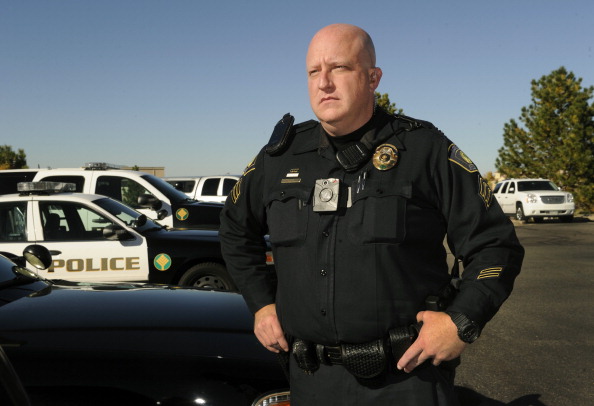
The LAPD could be the first top police department to outfit every officer with Taser’s Axon body-mounted camera.
A St. Louis County grand jury’s decision Monday not to indict a police officer in Ferguson, Mo., over the fatal shooting of an unarmed teenager has led to demonstrations around the nation. The lack of camera footage means no one knows for sure exactly what happened when the controversial shooting took place. Would better technology have helped? Taser thinks so.
Taser, of course, is best known for the tiny stun guns carried by police and sometimes civilians, made particularly famous a few years ago when a student at the University of Florida screamed “Don’t tase me, bro!” at officers arresting him during a speech given by then-Sen. John Kerry. Now, though, Taser is looking get the word out that it’s more than just a weapons company.
In addition to those stun guns, Taser sells Axon body-mounted cameras to police departments, and they’re used to record officer interactions with civilians. After an interaction is recorded, it’s automatically sent to Evidence.com, a cloud storage system run by Taser and built using technology provided by Amazon.
Earlier this month, Scottsdale, Ariz., -based Taser announced its biggest client yet — the Los Angeles Police Department. Although the order hasn’t come in yet, Taser’s CEO Rick Smith said he thinks the agency will make Taser’s Axon cameras standard equipment for all officers. Smith said an official order from the LAPD would likely come before the end of the year.
The LAPD would be the first of the five biggest police departments to make the cameras standard issue. Taser has also added the business of a number of other big city police departments — including Pittsburgh and San Francisco — over the past year.
Of course, Taser is not the only company looking to capitalize on the increased focus on police technology. Utility Inc., based in Tucker, Ga., has been making wireless routers that are used in cars for years. Recently, though, it has brought to market an on-body camera that’s similar to Taser’s Axon.
Taser’s CEO Smith says there’s a pressing need for better technology for police officers to increase transparency.
“We have [departments] that are still using VHS tapes to store their video,” Smith said. “The better way to think, from a practical perspective, about law enforcement, isn’t like the surveillance state of advanced technology, it’s like your local city government. This is a small department.”
Smith said there is a particular market for Taser’s cameras and cloud service because it all comes in one user-friendly package, meaning police departments don’t have to go through the bureaucratic procurement process for cameras, storage or servers — instead, Taser takes care of it all.
Utility also uses an Amazon-based cloud storage system for its cameras. CEO Bob McKeeman said he considers his company’s technology to be “Second Generation” because turning on a squad car’s lights, or opening the door automatically activates the cameras. Taser plans on introducing similar technology early in 2015, with the added bonus that when one camera is triggered, other cameras in the vicinity will also turn on.
For now, not every police officer is wearing a camera, mostly because not every police department can afford to buy the technology. McKeeman thinks prices will eventually come down as the price of the technology declines, and eventually cameras will become as commonplace as a radio in the police officer’s daily equipment set.
“We see it as inevitable,” he said. “Every police officer is going to have a body-worn camera.”
This article originally appeared on Fortune.com
Should Ferguson Protestors be Person of the Year? Vote below for #TIMEPOY
More Must-Reads From TIME
- The 100 Most Influential People of 2024
- Coco Gauff Is Playing for Herself Now
- Scenes From Pro-Palestinian Encampments Across U.S. Universities
- 6 Compliments That Land Every Time
- If You're Dating Right Now , You're Brave: Column
- The AI That Could Heal a Divided Internet
- Fallout Is a Brilliant Model for the Future of Video Game Adaptations
- Want Weekly Recs on What to Watch, Read, and More? Sign Up for Worth Your Time
Contact us at letters@time.com